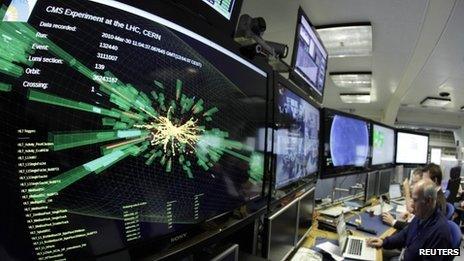LHC energy boost will aid hunt for Higgs boson
- Published

Two teams at the LHC have seen hints of what may well prove to be the Higgs
Scientists at the Large Hadron Collider (LHC) will increase the energies of the bunches of subatomic particles called protons that it smashes together.
The boost should improve the collider's chances of discovering "new physics" and definitively confirming or denying the existence of Higgs boson particle.
The proton beams' energies will be increased by 14%, for a total collision energy of 8 trillion electron volts.
<link> <caption>The announced increase</caption> <url href="http://press.web.cern.ch/press/PressReleases/Releases2012/PR01.12E.html" platform="highweb"/> </link> will break the LHC's own high-energy record.
Since first switching on in 2008, operators at the LHC have cautiously increased the energy contained in each of the bunches of protons sent around the 27km collider, which lies beneath the Franco-Swiss border.
The decision to turn up the energy when the collider switches on again later this year was taken at a <link> <caption>conference about the LHC</caption> <url href="https://indico.cern.ch/conferenceDisplay.py?confId=164089" platform="highweb"/> </link> in Chamonix in France.
"When we started operating the LHC for physics in 2010, we chose the lowest safe beam energy consistent with the physics we wanted to do," said Steve Myers, director for accelerators and technology at Cern, the laboratory that operates the LHC.
"Two good years of operational experience with beam and many additional measurements made during 2011 give us the confidence to safely move up a notch, and thereby extend the physics reach of the experiments before we go into the LHC's first long shutdown."
It is planned that the collider will collect data until November, after which it will be upgraded during a shutdown period that will last 20 months.
That should result in an operating proton beam energy of 14 trillion electronvolts, or teraelectronvolts - double the energy used to date.
The LHC collaboration hopes to reach that milestone in 2014, re-starting the hunt for "new physics" in early 2015.
In the 2012 run of experiments, the team hopes among other things to definitively confirm or rule out the existence of the Higgs boson, the particle hypothesised to be the origin of mass in the Universe.
In announcements made in December 2011, teams from the two major detectors at the facility announced they had seen hints of the particle but stopped short of claiming they had seen it with certainty.
Last week, the teams <link> <caption>formally submitted their papers</caption> <url href="http://press.web.cern.ch/press/PressReleases/Releases2011/PR25.11E.html" platform="highweb"/> </link> to academic journals for review by the scientific community.
While the <link> <caption>data from the Atlas collaboration</caption> <url href="http://arxiv.org/abs/1202.1408" platform="highweb"/> </link> largely repeated what had been reported in December, the <link> <caption>CMS collaboration's analysis</caption> <url href="http://arxiv.org/abs/1202.1488" platform="highweb"/> </link> included new data in support of a Higgs boson with a mass about 132 times that of the proton, slightly lower than that reported by Atlas.
Researchers are still investigating the discrepancy, which may affect the degree of certainty that the Higgs has in fact been glimpsed.
What is certain is that more data to be taken in 2012 will settle the debate.
While the collider's proton beam energies will be boosted by 14%, improvements in data handling and the ability to focus those proton beams mean that the machine's "luminosity" - a measure of how intense and productive the collisions ultimately are - should lead to a three-fold increase in data it produces compared to 2011.
- Published13 December 2011
- Published12 December 2011
- Published4 July 2012
- Published15 November 2011
- Published22 December 2011
- Published1 February 2011